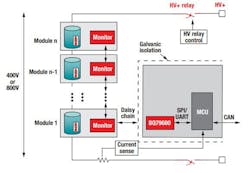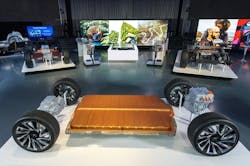This article is part of the TechXchange: EV Battery Management.
Members can download this article in PDF format.
What you'll learn:
- What are the BMS's primary responsibilities?
- Requirements for the BMS of tomorrow.
- Advances to enhance the BMS to meet future EV needs.
As EV batteries continue to evolve, so do their battery-management systems (BMS), which optimize their performance and longevity as well as protect them against catastrophic failure (Fig. 1). One of the latest developments in BMS design is the option to monitor and manage them via a wireless link.
This article explores the principles underlying wired and wireless BMS technologies. It also sheds light on some of the reasons why wireless architectures are better suited to meet the increasingly stringent requirements of modern battery packs.
BMS Functionality
A BMS's primary task is to ensure the electric vehicle’s (EV) battery pack is charged and discharged in a safe and efficient manner. It also must protect it against damage or premature aging, which can be caused by deep discharge or overvoltage, as well as excessive charge/discharge currents. Moreover, most automotive BMSs include a cell-balancing function and a high-voltage relay that’s responsible for safely disconnecting the high voltage from the main bus when vehicle isn’t in use.
To achieve this, the BMS must determine the battery's rate of charge/discharge, state of charge (SOC), state of health (SOH), remaining operating time, remaining charge cycles, and other critical variables. This information is derived from cell voltages, currents, temperatures, capacity, and, in some cases, internal cell pressure and the presence of moisture.
Distributed Battery Monitoring
EV battery packs are constructed from banks of pouch-style or cylindrical battery cells connected in parallel to deliver the required current. The parallel rows are then connected in series to produce the desired operating voltage.
Thus, monitoring a typical 400-V EV battery requires roughly 100 battery sensing points, and double that amount for an 800-V system. To monitor so many points without having to run wires all the way back to a centralized monitoring board, EV designers often employ what's known as a distributed BMS architecture.1
In a distributed system, the cells are monitored using an array of compact, high-accuracy, data-acquisition modules—known as cell monitor units (CMUs)—spread throughout the battery pack. Each CMU is responsible for monitoring and managing groups of several cells (typically six to 10).
Most distributed BMS systems use a wired connection to pass the voltage and temperature data collected by their CMUs to a central battery monitor unit (BMU). This connection is typically a serial daisy-chain bus that uses differential signaling to transmit the data across a twisted wire pair. Once the BMU receives and formats the data, it transmits it to the BMS controller, usually via a Controller Area Network bus (CANbus) interface.
Figure 2 shows a typical wired distributed battery-pack system for 400- to 800-V EVs.
Evolving Requirements
The BMS in today's EVs do a good job of ensuring rapid, efficient charging while protecting batteries against conditions that might degrade them prematurely or expose them to unsafe conditions. But tomorrow's BMS will have to meet a broader, more stringent set of requirements that reflect the realities of the evolving EV market2.
Higher Voltages
For over a decade, the most common operating voltage for EV traction systems has been 400 V, but this is changing as some automakers have begun to shift to 800- and even 1200-V systems. Using these higher operating voltages brings several advantages. Doubling the voltage reduces the current flowing through the EV's motors and batteries by half, enabling faster charging and the use of smaller, lighter motors. It also cuts the weight of the associated cabling by nearly half.
But the advantages associated with higher operating voltages don't come for free. Doubling the number of series cells required to support these higher voltages also doubles the number of connections the BMS wiring harness must support, adding to its weight and complexity. In addition, higher operating voltages make it more difficult to isolate the battery supply from the vehicle's primary controls and body electronics circuits.
Maintainability and Upgradability
Until recently, EV battery packs were constructed as monolithic units that were difficult to repair or service and could not be practically upgraded. This may be changing with the adoption of modular battery-pack architectures, such as GM's Ultium system.
The Ultium architecture enables the construction of modular battery packs that can be easily accessed to replace one or more damaged cells, or to swap in more advanced batteries as they become available. Any other manufacturer that adopts a modular battery architecture is likely to do the same.
Lighter, Simpler, Lower Cost
To gain wider market acceptance, EV manufacturers must begin to offer vehicles that are closer to the cost of an equivalent ICE-powered vehicle. This requires that all assemblies contain fewer, less expensive components, and require less labor to assemble.
Wireless Solutions
Wireless technology can be used to address many of the challenges faced by next-gen BMS systems. This approach replaces the wired serial interface between the CMUs and the BMU with low-power wireless transceivers.
The need for these links to operate reliably in environments with high levels of EMI has driven most wireless BMS architectures to employ one of several robust wireless personal-area-network (PAN) communication protocols that operate in the 2.4-GHz band. They include Zigbee, Bluetooth, and Bluetooth Low Energy (BLE).
Since these devices perform safety-critical operations, the system also may overlay the PAN protocol with additional error detection and correction mechanisms. Other vendors, such as Texas Instruments, have developed their own proprietary wireless protocols that can achieve packet error rates of 10-7 (or better).3
Figure 3 illustrates a wireless BMS network that consists of one main controller connected to a battery-pack MCU and eight wireless devices. Each wireless device has a companion battery monitor and balancer that measures the voltage and temperature of the battery cells in the BMS and reports SOC and SOH data to the BMS MCU through the main node controller.
One of the early adopters of wireless BMS technology is General Motors. Nearly all of the vehicles in its fleet will feature the Ultium architecture, making the batteries more accessible and able to accommodate replacements of individual cells.4,5 The Ultium architecture is composed of groups of cells banded together to form a battery module that, in turn, is clustered with several battery modules to form a battery pack that can contain either vertically or horizontally stacked cells (Fig. 4).
In addition to simplifying the pack's construction, using a wireless BMS helps designers achieve a compact flat form factor that stacks efficiently. The result is less wasted space, fewer electrical configurations, and a simplified cooling system.
Wireless BMS technology also is expected to be a key element of Hyundai's Integrated Modular Architecture (IMA), which will be introduced in 2025.6 According to the South Korean manufacturer, IMA is an evolution of their electric global modular platform (E-GMP), used currently in new battery electric vehicles (BEVs) throughout the Hyundai Motor Group (Hyundai, Kia and Genesis).
Hyundai said that the IMA will standardize not only a chassis, but also a battery system and motor. There will be nine standardized battery packs (with a cell-to-pack approach) and five standardized electric motors for the entire lineup of vehicles.
Read more articles in the TechXchange: EV Battery Management.
References
1. “Wired vs. wireless communications in EV battery management,” Taylor Vogt, Texas Instruments, 2020.
2. “More miles, fewer wires in future electric vehicles,” Texas Instruments, 2021.
3. “Improve wireless battery management with the industry’s best network availability,” Ariton Xhafa, Texas Instruments, Jan 7, 2021.
4. “GM’s Ultium Technology Explained Simply by Its Engineers,” Guillaume Rivard, The Car Guide, July 30, 2021.
5. “GM Ultium Battery — A Flexible Architecture For Next Generation EV,” Vincent Tabora, Medium.
6. “Hyundai Announce Integrated Modular Architecture (IMA),” Mark Kane Inside EVs, March 2022.
7. “wBMS: The New Competitive Edge for EV Manufacturers,” Murray Slovick, July 2021, Electronic Design.




